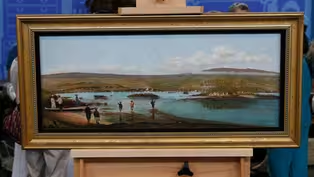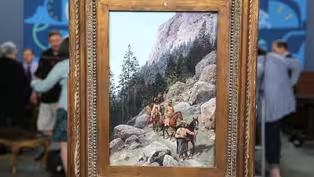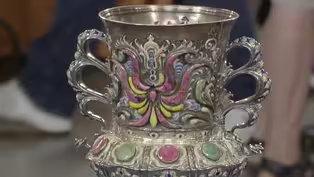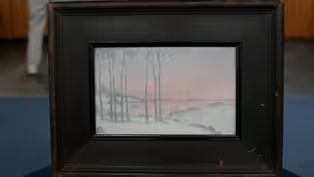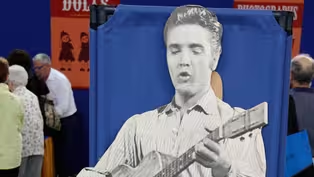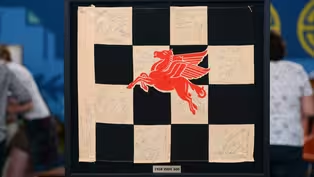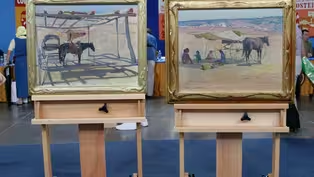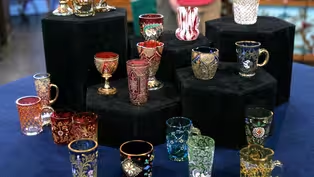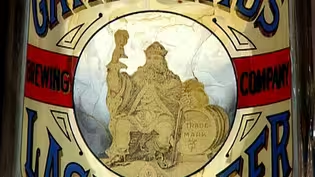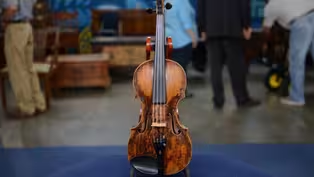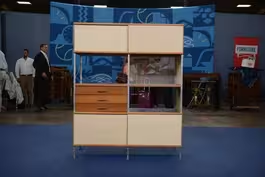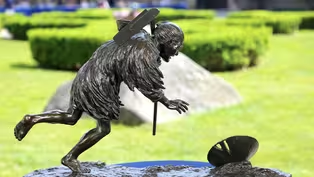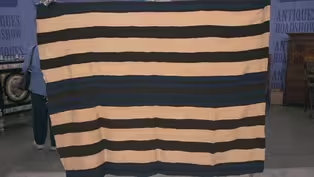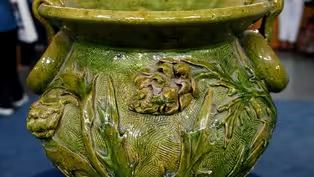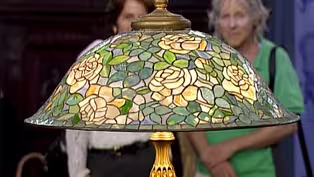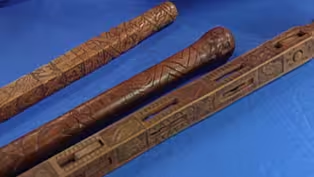
Tearjerkers
Season 25 Episode 22 | 52m 11sVideo has Closed Captions
Grab your tissues for an emotional special episode that includes a $1.5-$2 million find!
Grab your tissues for an emotional special episode full of guests who wear their hearts on their sleeves. Standouts include an 1888 Joseph Nāwahī oil, a Navajo Ute First Phase blanket, and a Gambrinus beer stein. One is now $1.5 million-$2 million!
Problems playing video? | Closed Captioning Feedback
Problems playing video? | Closed Captioning Feedback
Funding for ANTIQUES ROADSHOW is provided by Ancestry and American Cruise Lines. Additional funding is provided by public television viewers.

Tearjerkers
Season 25 Episode 22 | 52m 11sVideo has Closed Captions
Grab your tissues for an emotional special episode full of guests who wear their hearts on their sleeves. Standouts include an 1888 Joseph Nāwahī oil, a Navajo Ute First Phase blanket, and a Gambrinus beer stein. One is now $1.5 million-$2 million!
Problems playing video? | Closed Captioning Feedback
How to Watch Antiques Roadshow
Antiques Roadshow is available to stream on pbs.org and the free PBS App, available on iPhone, Apple TV, Android TV, Android smartphones, Amazon Fire TV, Amazon Fire Tablet, Roku, Samsung Smart TV, and Vizio.
Buy Now
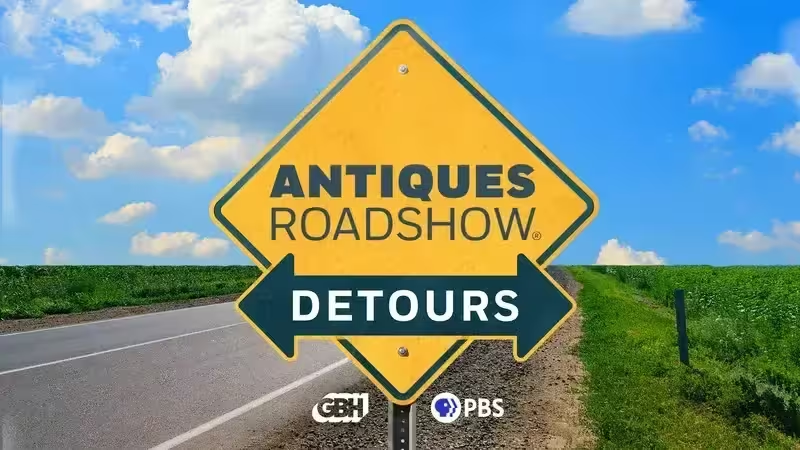
ANTIQUES ROADSHOW DETOURS
Ever wondered what happens to the treasures featured on America’s beloved ANTIQUES ROADSHOW after the cameras leave town? Host Adam Monahan tracks down the juicy afterlives of your favorite finds from PBS’s hit series.Providing Support for PBS.org
Learn Moreabout PBS online sponsorship♪ ♪ CORAL PEÑA: Get your tissues ready.
(voice breaking): I can't believe it.
Really?
(laughs) I had no idea.
Thank you, thank you very much.
APPRAISER: Thank you.
(sniffs) PEÑA: It's "Antiques Roadshow: Tearjerkers."
♪ ♪ PEÑA: Let's face it, sometimes we need a good cry, with emotional reminders of the past... (crying): As I looked at the, how much he paid for it growing up, I realized it was a huge amount for that day and time.
PEÑA: And what's been left behind.
This is a painting that I was given when my grandmother passed away.
PEÑA: In this special hour, we're celebrating the guests who wear their hearts on their sleeves-- the criers, the weepers, and the joyous.
(exclaims, sniffles) PEÑA: Like these overwhelmed sisters.
WOMAN: My mother found this in the late '60s.
There was a little neighborhood newspaper flyer and she read that there was a glass lamp for sale.
And my mother saw it, knew was it was.
And the woman, she also knew what it was.
It had belonged to her grandfather.
And she had moved into a very small studio apartment.
And it was just too large, and my mother asked her, "Well, what would you like for it?"
And, uh... She said $125.
Right.
$125.
So my mother... "Whoo," went to the bank real quick.
Purchased it, and has had it ever since.
And your family has taken very good care of it.
Yes.
Well, there's five of us, and, uh, my mother did hide it.
She had it hidden away in the house.
Special hiding place in the... And, 'cause we were kind of rambunctious, and, uh, it has just recently emerged.
Yes.
Well, let me tell you a little bit about your lamp.
You do know that it was made by the Tiffany Studios, which was the firm that was owned and operated by Louis Comfort Tiffany, who was the son of the founder of Tiffany & Company.
This probably dates from 1905.
The shade is called the rose helmet shade.
The "helmet," of course, refers to the shape, looking like a helmet.
WOMAN 2: Mm-hmm.
It rests on this absolutely magnificent example of a Tiffany base.
It has a wonderful Art Nouveau quality to it.
And it's called the Arc and Leaf.
And if you look down closely to the base, you will see these wonderful stylized leaf forms that follow all around the edge, and then are repeated in slightly different style moving up towards the top of the base.
Over the years, the bases and the shades can get separated, and what's very interesting about this base is that I believe that this has stayed together all these years.
If you notice, under the shade, this is gold leading.
And the gold leading matches the gold on the base.
And I have to say that the base is really unusual.
I can count on one hand how many times I've seen this base, it's so unusual.
This is a situation where the base is almost as great as the shade.
These were always luxury items when Tiffany was making them.
You would find them in the homes of many of the people who belonged to New York society.
This lamp probably cost in the neighborhood of maybe at least $200 to buy, and that was a lot of money in 1905, absolutely.
Back then, it was a lot.
WOMAN 2: The woman who was selling this, because she did know it was a Tiffany...
Yes.
...she had taken it into two dealers.
Mm-hmm.
In her area.
Right.
And the, the one dealer looked at it and she said, "It's not a Tiffany, it's the wrong finish on the base."
Okay.
And so she was turned around by two different dealers.
Okay, well, that's okay.
This is called the etched doré finish, it's as right as rain.
There's just, everything is beautiful about this lamp.
Now let me just give you the good news.
This lamp is worth between $80,000 and $125,000.
(both exclaim, sniffling) Mom had a good eye.
(both laughing and crying) Congratulations.
(laughing and crying) (applause) I have to give you guys a hug.
(women sobbing) APPRAISER: Isn't it great to get news like... Oh, you're so cute!
This is great.
Wow.
I'm a speedway sparkplug.
I grew up just a couple of miles from the Indianapolis Motor Speedway track.
And all through my grade school and high school days, I listened to the cars in the early spring, going around.
This flag was signed by 31 of the 33 drivers in 1958 at the conclusion of the race.
On the day of the race, on lap number one, 1958, all 33 cars were headed down the back stretch on lap number one, and two drivers, Ed Elisian and Dick Rathmann, tried to reach turn three, both of them at the same time, and it caused an accident that Pat O'Connor was killed in before they even completed lap number one.
Right.
So that's what makes this particular year eventful, but tragic.
Yeah.
And of course, it was later won by Jimmy Bryan.
Right, and we can only assume that this flag was probably started to be signed a day, two days, perhaps three days before, as we have Pat O'Connor's signature here.
The only thing we can't figure out between any of us is how Jimmy Bryan managed to save the center logo for himself.
Maybe there's a listener out there that can explain why Jimmy Bryan got to sign the center spot.
He was the winner.
Yep.
And it had to have taken place after the race.
Right.
But yet we have a signature on there of one driver that didn't even complete the race.
Right, and we've looked and we don't see Jimmy Bryan in another spot.
No.
Sometimes what we'll see is, we'll see the driver who wins on another spot, and then again in that center position after they've won.
We've got 18 other signatures on here of people that were related to racing.
Mm-hmm.
Racing dignitaries, former winners.
So you've got 31 plus 18, that's the number of signatures that are on this flag.
And as far as I know, it's the only flag of its sort.
Yeah.
Through your father's occupation, you got to meet a lot of these drivers.
I did-- my father had an accounting firm on Main Street, and so I grew up looking over the kitchen table, and my dad and maybe a couple of these drivers would be there.
And they'd have a cold beer while they talked taxes.
In 1956, I was in the soap box derby, and I had to build my own car.
And that year, Pat O'Connor came to our house to have his taxes done, and he brought Ray Nichels with him, his chief mechanic.
I said, "Pat, I've got my soap box derby out in the garage.
Would you like to come and see it?"
And he said, "Sure," and he got Ray Nichels, chief mechanic, and Pat, went out to my garage and they said, "Looks really good, Jackie, but you've gotta align the tires."
And they spent time and they got my tires aligned.
And I raced my car and I got more speed out of it in the soap box derby because of Pat O'Connor.
So tell me how you, how you got it.
A photographer by the name of Cooke had it.
He passed away about 15, 20 years ago.
An auction company had an estate sale and I went to that hoping to get photographs.
This came up for sale and I bid on it and bought it.
And how much did you pay for it?
No records, I couldn't find the receipt, but I think around $1,000, maybe $1,100.
I'm just in love with it.
I've kept it all these years.
Okay, sure.
What would you think it's worth today?
Oh, boy.
(laughs) Let's... think big.
Mm-hmm.
Maybe $3,000 or $4,000?
I don't know.
Yeah, it's quite the special piece for you to have brought in today, especially being here in Indianapolis.
I would put a value on this piece for insurance purposes of $10,000.
Wonderful, wonderful.
Wow, I didn't expect that.
(voice trembling): Yeah, marvelous.
Oh, my gosh.
Well, it's a part of my growing up and it will be passed on to my son.
WOMAN: They belonged to my father, his grandfather, and he was born in Lexington, Kentucky, and then grew up in Atlanta before he came west in the early 1900s.
Each piece is so remarkable.
The canes are really intricate, interesting, dated, signed.
This, this cane on the end has so much intricate work and... We call it a puzzle cane.
The other canes are equally detailed, and I love that it tells the journey of his trail out west.
This carving is especially interesting, given where we are, because he's in Tucson, Arizona, in 1938.
As a group, we would estimate them at auction for $12,000 to $14,000.
You're kidding.
My goodness.
(both crying) Oh, my gosh, you're kidding.
They're great.
They just stand in the corner and... We pull them out at holidays and look at them.
We never-- we never think of them as anything other than that.
They're excellent, they're great.
Oh, my...
They're great carvings.
Thank you so much.
You're welcome, thanks for coming.
Aw, thank you.
Oh... (laughs) (crying) Oh, don't cry.
You gotta be kidding.
I'm not kidding.
Oh, my God, we were dropping them outside.
So this is a painting that I was given when my grandmother passed away.
It always hung right above her bed.
Her dad, I'm guessing, would've given it to her after she spent the summer at a dude ranch, when she was 19 in, like, the '40s.
When I got it, there was a mosquito underneath the glass, so I took it out to the front yard and I opened it up to get the mosquito out so I could take it with me to college.
And then it kind of scared me a little.
I closed it back up immediately because it looked like it might be real.
And have you had it appraised before?
Do you know if she had it appraised?
It was appraised in, like, a general house appraisal twice.
In 1998, it was appraised as a print at $200.
And in 2004, it was appraised at $250.
Okay, do you know anything about the artist?
I know he was born in France and then he moved to Northern Pennsylvania.
So he could've been in the area at the time when he was painting it, when it was given to my grandmother.
And then he moved out to Ohio, but he had associations with, like, the Sioux tribe, so they actually adopted him in.
Okay.
And they gave him a cipher, Long Boots, and that's what that little circle underneath his signature is.
Mm-hmm.
That's the artist, it's Henry François Farny.
Mm-hmm.
He was born in France.
He came to Pennsylvania when he was about six years old.
When he was living in Pennsylvania, he began a relationship with the Seneca Indians, and that's really where his fascination with the different tribes began.
This piece is really interesting because it's a dense group of figures, which is very desirable in his work.
He did eventually spend a lot of time with the Sioux Indians, and they did adopt him and gave him the name Long Boots.
This is really his most prolific time.
1890 is about when we start to see some of his very best paintings.
He represented the Native Americans in a very kind of peaceful, tranquil way.
And you can see that in this painting, he didn't ever really bring conflict into his work, as some of the other artists from that time did-- Charles Russell and Remington.
So if we were going to put this in an auction today, I would suggest an estimate of $200,000 to $300,000.
(murmuring) (sniffs softly) (voice trembles): So I can't hang it up.
Oh, my God.
(exhales) That's so much.
(chuckles) (sniffs) I don't even know what to say.
Oh, my goodness.
(sighs): So I'll keep it away from my dog.
WOMAN: I bought this at an auction from an artist who was well known in the area.
I was excited to go to the auction.
Um, actually postponed a hernia surgery to attend the auction.
When I went to preview the auction, I suspected it was Eames, and then, when I looked in the drawer, I knew it was.
And so I sat through the whole auction and I won the bid, so... APPRAISER: The cabinet is designed by Charles Eames for the Herman Miller Furniture Company.
In the original catalogue from 1952, it was known as the E.S.U.
series.
Oh.
E.S.U.
standing for Eames Storage Unit.
This exact model was known as the E.S.U.
420-N. 420...
The N designation is for the neutral color palette.
400 is because of the 400 series.
Okay.
And 20 designation is for the drawers and door combination.
It was designed at a time when manufacturers and designers were teaming up and the best design minds were being paired with some of the best manufacturers.
Mm-hmm.
All of these parts were custom-manufactured.
There's actually 341 pieces on this cabinet.
Wow.
I counted them this morning.
(laughs) You're crazy.
(laughs) There's a lot of companies today that are very successful with producing something that comes in a flat pack and is shipped out, and the consumer actually puts it together.
Right.
This was far too complex for a consumer to assemble themselves.
Mm-hmm.
So these all had to be made in the factory at Herman Miller in Zeeland, Michigan.
They all had to be assembled there, then put in a large cardboard carton and a crate, and shipped out by rail or truck in 1950, across the country to their destination.
Right.
And actually proved to be a little too expensive.
And also, the design of the items suffered in transit.
The biggest flaw of this design is that the legs are very thin... Mm-hmm.
...and are designed to take a lot of weight compressed straight down, but they're not designed for lateral movement.
So in shipping, or when you pile a lot of heavy items on top of this... On top.
... and then you want to move it, even just an inch...
Right.
...those legs can kind of give way.
It has a label here in the drawer.
That label is from the early 1950s.
The reason I know this is from between 1950 and 1952 is that in 1953, this entire cabinet was redesigned.
Oh.
The weakness of the legs... Was fixed.
Was, was fixed, and new legs were designed that were inset into the bottom.
This version, which is commonly referred to as the first-series version, has these original legs.
How much did you pay for it?
Um, $15.
In 1952, these were about $200.
Mm-hmm.
Which was fairly reasonable.
In today's dollars, that would be about $1,700.
There's few of them that survive in, in good condition.
Mmm.
I would call this one of the best survivors... Oh, wow.
...I have ever seen, and I specialize in this type of design.
Wow.
At auction, which is probably the most common place that these would show up today... Mm-hmm.
...I think this would sell for about $20,000.
What?
Really?
Yes.
Uh... (laughing): Really?
Yeah.
Wow!
I was, I was going to be cool.
I had no idea.
I thought maybe $800.
Well, I have two like this, and two small ones, and we love them.
Oh, I had no idea.
Wow, that's very cool.
(laughs) Wow!
(laughing) I had no clue.
These belonged to my great-aunt and -uncle who were pioneer family founders in Northern Arizona, in Flagstaff.
My great-aunt came from Omaha, Nebraska, as did the artist.
I don't know if there's any other connection than that, but my family had a sheep ranch in Flagstaff, and he could very well have gone out with the sheep ranch and gone up on the reservation and painted the pictures.
Well, the artist, Augustus Dunbier... Mm-hmm.
...who signed each of these paintings in the lower left, does have connections, as you said, both to Omaha and the West.
When he studied at the Chicago Art Institute, he met a fellow artist and teacher, Walter Ufer, who was one of the Taos School artists.
Oh.
And Ufer invited Dunbier to come out to New Mexico in 1920.
So he started spending time every year in the West.
Even though he traveled a great deal, he would always go back to his studio in Omaha, where he painted for 62 years.
Wow.
Taught many classes, and he had much good advice for his students.
Mm-hmm.
One piece of advice that I particularly liked was, "Don't paint what you see."
He felt that the artist should manipulate the color to create a certain mood.
He often would make his own frames, and these are each in a lovely hand-carved frame.
Right.
Whether Dunbier actually made these, I'm not sure.
Mm-hmm.
But it's something that could maybe be ascertained with more research.
Mm-hmm.
So here we have a scene of a horse in what looks to be a very hot day in the landscape.
And here are some Indians also taking some respite from the sun.
If these were to sell in a retail situation... Mm-hmm.
...this one might be around $5,000 to $7,000, and this might be around $4,000 to $6,000.
Wow!
(crying): Amazing.
So I'm really glad to see some paintings today with some Arizona connection.
Yeah!
Thanks so much for bringing them in.
You're welcome-- thank you.
(stifling cry) (voice trembling): I told you I was going to cry.
(laughs) WOMAN: It was, I think, about 1965.
My family moved from Colorado to Washington, D.C. My dad took a job with the Department of Agriculture, and my sister already played the viola.
She's two years older than I am.
She was already in junior high.
I would have been starting sixth grade, so my mom wanted to start me on an instrument, a string instrument, and we chose the violin.
So we went to downtown Washington, D.C.... Did you buy it at a violin shop from a violin dealer?
Yes, and it was hanging from... All these, I don't know how many, 50, 60 violins hanging from the ceiling.
I mean, they must have been down low enough that you could grab them.
But I just remember walking into this room and I saw this violin in the back of it.
Is kind of white and then it goes out to brown.
That's what caught my eye first.
But then when he got it down for me, it has a wax seal on the back.
Oh, yeah, okay.
That says, "M.D."
We're gonna look at that.
We lived in Maryland, so I thought, "That stands for Maryland."
An owner who owned it at one point put his seal on the back.
Oh.
When my dad saw the cost... And how much was that?
It was $600 in 1965, but we bought a brand-new car to drive across country, and it was $3,000.
And so, $600 of that-- at the time, I'm a kid, I'm, like, 11 or 12 years old.
It seemed like a lot of money.
Sure.
Yeah, it was a big chunk of money at that time.
And my dad went ahead and bought it for me, the one I wanted, so... You looked at the label inside, which was now a bit obscured, and you found a date on the inside, 1760s date.
I can't really make out what the label says, but I can tell you, the violin is made about 1750, 1740.
Okay.
It looks like a fake label put in later at some point, but the instrument is German, maybe made in Nuremberg.
Maybe Vienna, but I think more like Nuremberg.
One of the better families of makers, perhaps the family named Widhalm, W-I-D-H-A-L-M, Widhalm.
Reminds me of Widhalm instruments.
And one of the reasons it does is not just this beautiful outline, with these beautiful small edges and little corners, but also this really intricately carved head-- really clean work and the kind of work that was not quickly done.
This is definitely handmade by a small workshop or a particular maker, and very high grade of work.
And this was... By craftsmen.
... stylistically, I think, their Amati model, which is a very common model of the period.
The fact that the wood is not very fancy, that's okay.
It's not unusual to have plain wood for these German makers.
All this brown, dark finish, that's original to it, and this used to cover the whole instrument.
Over the years, that all gets worn down.
This violin retains its original neck.
Generally speaking, in the 19th century, most of these short-neck instruments of the earlier periods had their necks removed.
They would remove it right at the base of the head, put a longer neck in, put the head back on.
This one has the original neck, and it was reangled at the heel by adding wood to it.
It's been modernized.
Oh.
But 19th-century modernized.
It wouldn't take much to get this up to snuff cosmetically, but basically, structurally, it's great.
There are some old cracks in the head, but I'm not that bothered by that.
In a retail shop environment, it should be worth at least $10,000.
(gasps) And I'm thinking somewhere between $10,000 and $15,000.
Oh, you've gotta be kidding.
No, that's about right.
And overseas, in Germany, where the market is even a little stronger for this type of instrument, perhaps even more, so... Perhaps, if this were cleaned up a bit and it were brought up to modern standards, maybe even getting up towards $20,000.
(voice breaking): Oh, my goodness.
That's... (laughs): That's incredible.
It makes me miss my dad even more.
He's gone.
Oh... (crying): You know, as I looked at the, how much he paid for it growing up, I realized it was a huge amount for that day and time.
But a good choice.
And I'll bet if my dad knew how much it was worth, he would still pay that much.
That would make him happy.
He loved us that much.
I don't know an awful lot about it, except that it was given by Kit Carson-- who I'm sure everybody knows, and his history-- given to the foster father of my grandmother.
And do you know who made this weaving?
Do you know what kind of blanket it is?
Uh, it's probably a Navajo, but that's about all I know.
Well, Ted, did you notice, when you showed this to me, that I kind of stopped breathing a little bit?
Yeah, you did.
(laughs) I'm still having a little bit of trouble breathing here, Ted.
You took me by surprise, because I, you know, I didn't think much about it.
Probably a chief blanket.
That's exactly what it is.
And it's not just a chief's blanket, it's the first type of chief's blanket made.
These were made in about 1840 to 1860, and it's called a Ute, first phase.
A Ute?
A Ute, first phase, wearing blanket.
A Ute, first phase, wearing blanket.
Chief's wearing blanket.
But it's Navajo-made, they were made for Ute chiefs, and they were very, very valuable at the time.
This is sort of, this is Navajo weaving in its purest form.
All of these things that we see later, with diamonds and all kinds of different patterns, comes much later than this.
This is just pure linear design.
Yeah.
This is the beginning of Navajo weaving.
The condition of this is unbelievable-- unbelievable.
We see these, we've got a little bit of damage over there.
It's made from handwoven wool.
Yeah.
But it's so finely done, it's like silk.
Wow.
It would repel water.
And this here is dyed with indigo dyes.
It was a very valuable dye at the time.
And what's really interesting is, right here, we have an old repair that was probably done in the 1860s.
Wow.
And it's done with raveled bayetta, which is in itself a very important thing in Navajo weaving.
So all involved, it's an extraordinary piece of art, it's extremely rare.
It is the most important thing that's come in to the Roadshow that I've seen.
Do you have a sense at all of what we're looking at here in terms of value?
I haven't a clue.
Are, are you a wealthy man, Ted?
No.
Well, sir, um...
I'm, I'm still a little nervous here, I have to tell you.
On a really bad day, this textile would be worth $350,000.
On a good day, it's about a half a million dollars.
(exhaling): Oh, my God.
And you had no idea.
I had no idea.
It was laying on the back of a chair.
Well, sir, you have a national treasure.
Wow.
A national treasure.
Gee.
When you walked in with this, I just about died.
Gee... Congratulations, congratulations.
I can't believe this!
Now, the value of this that I'm giving is, is not using the Kit Carson provenance.
Provenance is sometimes very difficult to ascertain.
If, if we could do research on this and we could prove with a, without a reasonable doubt that Kit Carson did actually own this, um, the value would increase again-- maybe 20%.
Wow.
I can't believe it.
My grandmother, you know, were poor farmers.
They didn't... She had, her, her foster father had started some gold mills and, and, you know, discovered gold and everything, but there was no wealth.
No wealth in the family at all.
Whoa... (voice breaking): I can't believe... Congratulations.
Thank you.
Gee, wow.
I'm amazed, I'm flabbergasted.
WOMAN: When I was a teenager, I saw this man at my godmother's house.
She said, "One day I'm gonna put this in my will and it'll be yours."
(laughs) Recently, she just gave it to me.
He's just something that I've always treasured, 'cause he's different.
I like the fact that his hat is missing, it's gone, but he's trying to get to it.
And I like the movement that's in his clothes.
APPRAISER: So this fellow was working, and then the hat blows away and it's blowing away on a wave.
Oh...
This is water.
You can see, it's kind of breaking and frothing and so on-- it's shallow.
Yes.
But it's water.
He is in a rice field.
Uh-huh, oh.
On his back, this is where he would put the hoe, and here he is, just leaping forward, just this spontaneous reaction.
That's what that sculptor wanted to do, and that is characteristic of a particular school of artisans who were working in the late 19th century in Tokyo.
It's made of bronze.
And it was in response to a change in Japan, during the Meiji period, where there was a real effort to industrialize Japan and move it forward to become part of the world of nations, to become part of international commerce.
Mm-hmm.
And so they were creating things that could be sold to a foreign audience and they would be displayed in World's Fairs in places like St. Louis, and Philadelphia, and Chicago.
Right here is a little square mark.
Mm-hmm.
And it says a number of things, but what's important is that it says "Kaneda."
Oh.
And that is the name of the sculptor.
And we know that Kaneda worked in the late 19th century.
This happens to be one of the very best examples that we know of by this particular artist.
Oh, wow.
You can see the detail on the clothing.
Mm-hmm.
And on the waves that are cresting.
The face, the features.
Mm-hmm.
This is a wizened old man who's gone through a whole lifetime of work.
From a technical standpoint, creating a figure that's supported by one leg is hard.
Yes.
You've got to balance the weight.
Okay.
And this is a fairly heavy object.
So one of the ways that is achieved by the base extending so far.
Okay.
So that's also part of the scene, but also look what the figure does.
It extends far, as well, and there's enough weight that's balanced by this, and...
When you pull it out, you can see that it's got this fairly substantial block attached to the end of the foot.
Yeah.
So that this is not going to move.
That's right.
And all that was calculated by the sculptor when he came up with this idea.
For retail replacement purposes, I think a figure of $12,000 would be about right.
(laughing) Really?
I had no idea.
(laughing and crying) That's wonderful.
(laughs) Oh, my gosh, thank you.
(exhales): Wow.
(exhales): That's really something, I had no idea.
(laughs) Well, this was my grandmother's, and she had it over the kitchen sink on a shelf, and she'd always put her string in there.
Mm-hmm.
She'd go to the bakery and get a cake or something, and it was always wrapped in paper, which... And that was the jar, she stuck a string for future use.
Well, it's a wonderful thing.
I see we have an original maker's label in here, where it was made, in New York City.
This dates from around 1880.
Oh!
These were made to be on display behind a bar to advertise the beer.
In this case, Gambrinus Lager Beer.
Yes.
It has a reverse on glass applied label.
This is a curved piece of glass, actually painted on reverse, and then applied to the mug.
Most commonly, you find bottles, like a liquor bottle would say the, the name of the brand of liquor.
Mm-hmm.
And it would have a beautiful label on it.
It's very rare to see a beer stein advertising beer with this reverse on glass.
When I looked into the side here, I saw another little label, a little paper label with 50 on that one.
Oh.
Oh, I was going to have a garage sale.
Mm-hmm.
And I put prices on a couple of things I had, but I never had the garage sale.
(chuckles) I wish I'd been at that garage sale.
Because I'll tell you-- you know what this is worth?
Haven't the faintest idea.
Between $2,000 and $4,000.
Oh, go on.
Yes, indeed.
(whimpering) So you have a real, real treasure here.
(breathlessly): $2,000 to $4,000?
Yes, at, at an auction, where you had some real competition, you could certainly bring $2,000 to $4,000.
And who knows?
Maybe a little more.
(voice breaking): I can't believe it.
Take good care of it.
(whimpers): Well, thank you.
WOMAN: It was my grandmother's, and about ten years ago, my mother gave it to me.
My grandmother came from Italy, on the boat, it landed in the United States sometime in the 1800s, and my mother was born in 1917, so...
I don't know whether it came from Italy, or if she purchased it after she was in New Orleans and got married.
I think what this is, is a piece of New Orleans Art Pottery.
Now, New Orleans Art Pottery was very short-lived operation.
Its roots were in 1885.
Sometime around '88, '89, they were already out of business.
And teacher Ellsworth Woodward went to New Orleans to teach the ladies how to do decorative arts, and started the Ladies Decorative Arts League in 1885.
In '86, on Baronne Street, opened up a pottery and brought in two potters, Joseph Meyers and the famous George Ohr.
George Ohr actually left his own pottery here in Biloxi to go to New Orleans to throw pots for a couple of years with Woodward and with Meyers on Baronne Street.
So I think this is one of those pieces.
Now, how do we, how do we know this without a mark on it?
This work is so obscure.
There are maybe 20 pieces known of the New Orleans Art Pottery.
Utilitarian forms such as jardinières predominated and they were used and they were broken.
So what do we look for?
Several things-- number one, this crosshatching on both sides is typical of work I've seen on New Orleans Art Pottery.
It's somewhat of a fingerprint.
I think more importantly, this piece has a sophisticated crudeness.
If you look at the way the handles are formed on the top, the lumpiness of the decoration.
On the other hand, it's really well done.
It's, it's an oxymoron, because it's got elements of high art and heavy-handedness at the same time.
If we look inside, at the clay, that is the clay I've seen on pieces made from the New Orleans Art Pottery.
It looks like mud from the New Orleans streets.
In addition to that, there are very fine lines going around this pot as though someone used a sponge or a finishing tool while it was still on the wheel to even out the inside.
Several of the pieces I've seen of New Orleans Art Pottery had these concentric circles going through the inside of the pot.
So again, there are many elements of this.
I doubt very much that your grandmother brought a jardinière over from Italy with her on the boat.
Right.
I mean, it's much more likely she would have found it here, arriving in New Orleans, which is where this pot would have been made, so...
Okay.
I think the odds are about ten to one that this is a piece of New Orleans Art Pottery.
This is in amazing condition, considering what it must have been through for 130 years?
If this was just another Victorian cast pot in a majolica style, which this glaze is, it's worth $100, okay?
Because it's a hand-thrown one, rather than cast, I'm thinking perhaps, at auction, a piece like this would bring somewhere between $400 and $600.
If it's a piece of New Orleans Art Pottery, and we're pretty sure about that, at auction, the value is somewhere between $10,000 and $15,000.
(exhales) If we find a picture of this piece...
Okay.
...in our research, I think we have a piece of New Orleans Art Pottery worth between $20,000 and $30,000.
Oh, my word.
Okay?
It just gets better.
So, I think you're looking at a piece probably that's going to be worth, estimated, at auction, somewhere between $10,000 and $15,000, but we're gonna get back to you on that one, okay?
Okay, all right, wow.
(breath trembles) (voice breaking): Where should I keep it?
Uh, not on the floor, where you had it sitting a little earlier.
Even though it's meant to have flowers put in it, I'd definitely keep it protected.
Thank you.
You're welcome, my pleasure.
From what I understand, it's called a standee.
I am an avid Elvis lover.
You have your T-shirt on, I can see that.
Yes, and believe it or not, just some awesome friends of mine were cleaning a home that they bought out to renovate.
And lo and behold, in the attic was... Elvis.
And the minute they found it, Jack said to his wife, "Well, Joan, we know right where this is going."
I'm sure you're very familiar with the, Elvis's career.
Yes.
And this one's particularly important, because it's his first feature-length film.
And at the time, the film was supposed to be called "The Reno Brothers," which were the title characters.
But his hit single "Love Me Tender" had already sold a million copies, so the song was so popular at this point, they actually retitled the film.
But because it was his first appearance, he actually got third billing in the film, which he-- that never happened again, obviously, because he was such a huge star.
They were made to decorate the, the lobbies of the movie theaters when the, the films came to town, and they would be passed on oftentimes to the next theater.
Well, as you can see, you do have a crease.
That's pretty common.
Most of these were just in pieces by the time a film's run would be finished.
The crease across the center, that's how it was made.
They're made to fold so they can be shipped.
There were reports that you couldn't hear the film because the girls in the theater were screaming so loudly, because their, he was such a heartthrob.
So I would imagine that many of these were also probably torn to shreds by fans coming out of the theater... (laughs) ...who wanted a piece of Elvis to take home.
You keep this by your bed.
Oh, yes.
And you wake up every morning and see Elvis.
Oh, yes.
There are only about two or three of these known to exist.
Really?
So many were destroyed.
So at auction, I would estimate it at least $10,000 to $15,000.
Oh, my God.
So are you gonna keep it by your bed still?
(laughs): Oh, absolutely.
You're kidding!
No.
I've never seen one before, I've only ever seen pictures.
So... You made my day.
I'm glad.
And of all people, with Elvis, thank you very...
Thank you, thank you very much.
Thank you.
(voice trembling): Thank you very much.
You're welcome.
Oh, my God.
They're... Really, really, the only people who have them are probably the very highest-end Elvis collectors, so you're, you're in that, that group.
Really?
(laughs): Yeah.
MAN: Well, I inherited this painting from my parents.
My mother wanted to give my father a gift that he would really love.
And he loved reading to his children books that had illustrations.
APPRAISER: Mm-hmm.
And this is one of the illustrations.
She knew how much he would love to get one of those, so she decided that she needed to make this a secret.
So what she did was, she saved five dollars from her food money every week for probably two years.
Oh, wow.
And didn't tell him this.
Amazing-- right.
And then it's either his birthday or their anniversary, gave him a card that said, "You can go down to the Schoonover Studios and pick out a painting."
Oh, that's... And he was elated, to say the least.
Oh, how exciting.
And so we went down as four kids and the mom and dad, and we chose a painting.
What I remember, this would have been in the early '60s.
Mm-hmm.
Early to mid-'60s, I'll say.
Okay.
Dark wooden floors, paint.
I think there were big windows at one end.
Mm-hmm.
And there was partially completed canvases here, there was, you know, old, probably, I'll say discarded ones there, and, you know, then there was...
There was sort of stacks of them.
Mm-hmm.
This is the one with the clipper ship, which he thought was extraordinary.
Right.
And then this galleon, and...
I don't know, he just, he decided on that one, and we all, of course, were thrilled.
And the title of the painting is... "Privateers of '76."
Right.
The story was written by an author named Ralph D. Paine, who apparently wrote several books in the early 20th century, and a lot of them relating to history.
On the back of the painting, we have the inventory number for the painting, which is number 1248.
Mm-hmm.
There is a label, which actually is handwritten, and maybe by Schoonover himself, that says it, it's from chapter 13.
The title of the illustration is "At a hail from the boat, he went to the rail."
"At the hail of the boat," meaning the one below, the figure on top comes to the rail.
Now, Schoonover, of course, is one of the premier artists of the Brandywine School.
And he studied with Howard Pyle...
Yes.
...who is considered the father of the school...
Yes.
...at Drexel Institute in Philadelphia.
Oh, I didn't know that.
And Schoonover was very good at, at wanting to get to reality.
So not only did he go out west, but he also went down to the bayous in Mississippi to sort of get a sense of how the pirates would have lived in that environment.
He had a house in Bushkill, Pennsylvania, in Pike County, which is in the Poconos.
Mm-hmm.
And he would spend his summers there.
But he used the landscape of that area in, in many of his paintings.
You know, I think that the card that Mr. Schoonover gave my parents when they purchased this said that it was painted in Bushkill-- is that what it's called?
Yes, Bushkill, Pennsylvania.
Yes, yeah.
And certainly, he was very popular, especially in the early part of the 20th century, because he illustrated such classic books as "Robinson Crusoe"... Mmm.
"Swiss Family Robinson."
And he did a whole series of books for, on Zane Grey Western novels.
Oh, really?
Oh, my gosh.
So he was quite into it, as well as magazine illustrations.
Mmm.
He was born in 1877 and he actually lived to 1972.
So he was primarily painting in the early 20th century, and really, I think, up until he passed away.
The painting, of course, is oil on canvas, and looks like the original frame.
This painting is dated in the lower right '23, 1923, and that's when the novel was first published.
Hm.
He is popular as an illustrator nationwide.
If this were in a gallery, I think that it would sell in the range of $125,000.
(chuckles) I know you're kidding me.
No, I'm not kidding you.
It's a wonderful... (softly): Really?
Yes.
Really?
It's a wonderful painting.
(breathes deeply) My father would be so thrilled to know that people were being turned on to illustrations.
Yeah.
And my mother would be really thrilled at what you just said.
Yeah.
(both laughing) Well, it means that her investment was a good one.
Oh, yes, oh, yes.
Wow.
There's a big surge of interest in illustration.
Well, I love this painting.
Yeah.
I love this painting.
WOMAN: I got it from my uncle's aunt.
She lived in Chicago.
APPRAISER: Okay.
That's about all I know about it.
Well, you know a little more-- you know who made it.
Yeah, it's on the bottom.
Yes, and what does it say?
Tiffany and Company.
And what else does it say?
Sterling silver.
Okay.
And the letter T and some numbers.
Well, the letter T means it was made between 1891 and 1902, when Charles Tiffany was in charge of, of the production.
The first number is the pattern number and the second is the order number for the piece.
It's very unusual, and not only is, is it sterling, but it has enamel on it-- beautiful enamel decoration.
Ooh!
It's almost over the top, I have to admit that.
And then all of the, the stones are actually American stones.
They're American turquoise.
Oh, really?
And various other stones, plus the enameling.
Wow.
And as I said, with the sterling mark.
You have no idea where she got it?
None.
But she lived in Chicago?
She lived in Chicago, right downtown, on, near the Midway Plaisance, which was part of the site of the Columbian Exposition.
So I don't know if that has anything to do with it or not, but... Now, when was the Columbian Exposition?
(sighs): 1893, I believe.
Okay, well, I think you've got a winner here.
This was made for the Columbian Exposition.
It was?
Really?
Oh, my God.
Yes, by Tiffany.
When you first came in, what did you tell me when you took it out of the bag?
I said, "It's ugly."
Well, and I agreed with you.
(both laughing) But boy, the more I looked at it, I couldn't believe how wonderful it was, with all of these stones, and then to check the mark and everything.
It is absolutely spectacular.
(laughs) And when you turn it over, down here, at the very bottom of the mark... Yeah?
There is a globe with a T superimposed on it.
I saw the T. And a little tiny line in the middle that says "Tiffany."
And that was the exhibition... Oh, my God.
...signature for pieces in the World's Fair.
Oh!
So your great-aunt must have had some very special friend that gave it to her.
Wow.
Or one of her husbands, maybe?
(laughing) Okay, well...
There were, there were several, yes.
There were several.
(both laugh) Well, she must have done something right to get this piece.
(sighs) Now, do you have any idea what it's worth?
Well, just because it's sterling, maybe $15,000?
If it was sterling, that's what it would be worth.
But with all the enameling and everything else, an auction value on this piece in today's market-- which is a little conservative-- I would say $50,000 to $100,000.
Oh, my... (gasps) You're kidding!
No.
Do you still think it's ugly?
Yes.
(laughing) (sniffles) Excuse me... How much?
$50,000 to $100,000.
Okay.
(laughs) (sniffling): But it's still ugly.
(both laughing) It's signed down here, J. Nawahi, 1888.
Joseph Nawahi, he wasn't primarily a painter, was he?
No, that's probably the least of his known attributes.
He was a lawyer, he was a legislator, he was an educator, and he was the publisher of a newspaper.
He was in the legislature for 20 years.
He produced a newspaper critical of the rebellion and the overthrow of the government, and actually landed in jail from around 1893, '95, and subsequently caught tuberculosis and died in '96.
Yes.
But he was native-born Hawaiian.
We see these two snow-capped peaks here.
Uh-huh.
And those are...
They're the two mountains on the Big Island.
Right.
They're Mauna Kea and Mauna Loa.
Right, it's volcanoes there.
Right.
This bay here is, is probably where?
It's the Hilo Bay.
On the Big Island.
Right.
And then this island there?
It's called Coconut Island.
He was an amateur painter, and if you look at the figures, sometimes the anatomy and the perspective isn't always right.
They're a little bit stiff.
He's a good artist, but not a great artist.
He has a good sense of the, the landscape, but he's not an academically trained artist.
Yeah.
He had some training, but not much.
But it's important because he's the first Hawaiian-born to paint in this Western style.
He was known for doing volcanoes, much like Jules Tavernier.
There aren't many paintings by him.
I think he-- how many are there?
There are... We only know of five.
This is either the largest or one of the two largest ones.
Where'd you get it?
Well, we were on our way from our property up in Volcano down to Hilo Town to go to a museum, and we stopped on the way at our favorite antiques gallery, saw this, couldn't quite make out the artist's name, but got a fix on it, and we had to rush off.
So we went down to the museum and we saw his name there.
My husband and I, we looked at each other and we said, "The painting!"
And called the antique shop and asked them to hold it, and we zoomed back up there and we got the painting.
I think we paid about $400 for it.
About $400.
That was in the '70s.
It was very dark and it was grazed.
The old painting had cracked and everything.
So a friend of ours sent it to his restorer in San Francisco, I think it was.
It was somewhere in California.
And so we did have him do that.
That has an effect on, on value on anything.
But when you're talking about five or six pieces that are known... Uh-huh.
We sort of forgive some of the condition issues.
Do you remember what you paid for the restoration?
Probably between $600 and $900.
I consulted with one of my colleagues here who is from the islands.
Because you have the Hilo Bay, you have Mauna Loa, Mauna Kea, he called it Hawaiian gold for, in, in the art market.
Mmm.
Recently, works by him have sold as much as $70,000.
I think, if this were to be up at auction today, I would probably put an estimate of $100,000 to $150,000 on it.
Are you kidding?
No, it's a great thing.
(laughing): Wow.
Wow.
It's, it's really important.
This is a national treasure.
Yeah.
Yeah.
I mean, it's an amazing thing to have here.
Well, I'm Native Hawaiian.
This is... Yeah.
So it's one of the reasons we bought it.
Oh, it's great.
Oh, gosh.
(laughs): I've got goose skins.
Yeah.
Well, take good care of it, you know?
And put it in a very safe place.
Mm-hmm.
And keep it under lock and key.
(chuckles) (voice trembling): Excuse me.
It's all right.
We're very proud to have this picture.
Yeah.
Thank you so much.
All right.
Well, thanks for bringing it in-- it made my day.
(laughing): Thank you.
WOMAN: I found it in a shed.
It was covered with filth.
I just kind of cleaned it up a little bit, and it's been hanging in my bedroom.
And when we got tickets for the show, I was trying to think of what to bring, and I thought, "Well, I'll take that plaque and see if I can find out anything about it."
This was made by the Rookwood Pottery.
They worked in many different types of glazes and lines, and this is called a scenic vellum plaque.
It has a snowy dusk landscape, which is very desirable.
The artist has signed right here.
Her name was Sallie Coyne, and Sallie Coyne was with them from the 1890s all the way until 1936, a few years before she died.
This is mounted in its original Arts and Crafts frame.
That is the Rookwood Pottery mark.
RP.
And when it's filled with these little flames, the dates after 1900 are added in Roman numeral.
So this is 1918.
This is the original price of two dollars.
Wow.
Now, you said you've cleaned some of it.
Did you remove the piece?
No-- no.
You can pop these little nails out and soak it in very warm water and a little bit of detergent.
Soak it overnight, and that will get into some of the crazing over here, and that should lighten all of that.
This glaze is very matte, which was arrived at by putting an overglaze of lots of little bubbles that refract the light.
Would you like to know what it's worth?
Yes.
(laughs) Two dollars.
$4,000 to $5,000.
(softly): Oh, my gosh, you're kidding.
(whimpers) That's amazing.
(both laugh) (sniffles) (crying): Good.
I'm glad it's good news.
(laughs) I think it's good news, right?
It is, it is.
Wow, that's really something.
Two dollars it sold for, huh?
Wow.
(crying): I can't believe that.
Aww... (sniffles): That's great.
PEÑA: Thanks for watching.
See you next time on "Antiques Roadshow."
Appraisal: 1888 Joseph Nawahi Painting
Video has Closed Captions
Clip: S25 Ep22 | 3m 27s | Appraisal: 1888 Joseph Nawahi Painting (3m 27s)
Appraisal: 1892 H. F. Farny Watercolor & Gouache Painting
Video has Closed Captions
Clip: S25 Ep22 | 3m 10s | Appraisal: 1892 H. F. Farny Watercolor & Gouache Painting (3m 10s)
Appraisal: 1893 Tiffany Columbian Exhibition Piece
Video has Closed Captions
Clip: S25 Ep22 | 3m 10s | Appraisal: 1893 Tiffany Columbian Exhibition Piece (3m 10s)
Appraisal: 1918 Sally Coyne Rookwood Plaque
Video has Closed Captions
Clip: S25 Ep22 | 2m 31s | Appraisal: 1918 Sally Coyne Rookwood Plaque (2m 31s)
Appraisal: 1956 Elvis "Love Me Tender" Standee
Video has Closed Captions
Clip: S25 Ep22 | 2m 21s | Appraisal: 1956 Elvis "Love Me Tender" Standee (2m 21s)
Appraisal: 1958 Signed Indianapolis 500 Racing Flag
Video has Closed Captions
Clip: S25 Ep22 | 3m 55s | Appraisal: 1958 Signed Indianapolis 500 Racing Flag (3m 55s)
Appraisal: 20th C. Augustus Dunbier Oil Landscapes
Video has Closed Captions
Clip: S25 Ep22 | 2m 14s | Appraisal: 20th C. Augustus Dunbier Oil Landscapes (2m 14s)
Video has Closed Captions
Clip: S25 Ep22 | 35s | Appraisal: Cordials Collection, ca. 1875 (35s)
Appraisal: Gambrinus Advertising Beer Stein, ca. 1880
Video has Closed Captions
Clip: S25 Ep22 | 2m | Appraisal: Gambrinus Advertising Beer Stein, ca. 1880 (2m)
Appraisal: German Violin, ca. 1750
Video has Closed Captions
Clip: S25 Ep22 | 4m 32s | Appraisal: German Violin, ca. 1750 (4m 32s)
Appraisal: Herman Miller Storage Unit, ca. 1950
Video has Closed Captions
Clip: S25 Ep22 | 3m 57s | Appraisal: Herman Miller Storage Unit, ca. 1950. (3m 57s)
Appraisal: Kaneda Kenjiro Bronze Sculpture, ca. 1890
Video has Closed Captions
Clip: S25 Ep22 | 3m 32s | Appraisal: Kaneda Kenjiro Bronze Sculpture, ca. 1890 (3m 32s)
Appraisal: Mid-19th Century Navajo Ute First Phase Blanket
Video has Closed Captions
Clip: S25 Ep22 | 3m 42s | Appraisal: Mid-19th Century Navajo Ute First Phase Blanket (3m 42s)
Appraisal: New Orleans Art Pottery Jardiniere, ca. 1886
Video has Closed Captions
Clip: S25 Ep22 | 3m 48s | Appraisal: New Orleans Art Pottery Jardiniere, ca. 1886 (3m 48s)
Appraisal: Tiffany Studios Rose Helmet Lamp, ca. 1905
Video has Closed Captions
Clip: S25 Ep22 | 3m 51s | Appraisal: Tiffany Studios Rose Helmet Lamp, ca. 1905 (3m 51s)
Appraisal: Wood Carving & Walking Sticks, ca. 1930
Video has Closed Captions
Clip: S25 Ep22 | 1m 24s | Appraisal: Wood Carving & Walking Sticks, ca. 1930 (1m 24s)
Providing Support for PBS.org
Learn Moreabout PBS online sponsorship
- Home and How To

Hit the road in a classic car for a tour through Great Britain with two antiques experts.













Support for PBS provided by:
Funding for ANTIQUES ROADSHOW is provided by Ancestry and American Cruise Lines. Additional funding is provided by public television viewers.


